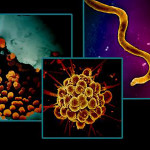
Still from Julie Tolentino and Abigail Severance’s “evidence”
To honor the 25th year of Day With(out) Art on December 1, 2014, Visual AIDS commissioned seven artists/collectives--Rhys Ernst, Glen Fogel, Lyle Ashton Harris, Hi Tiger, Tom Kalin, My Barbarian, and Julie Tolentino and Abigail Severance--to create provocative new short videos that reflect and respond to the ongoing AIDS pandemic for a program titled ALTERNATE ENDINGS.
Here, Vivian Crockett considers Julie Tolentino and Abigail Severance’s contribution to the video program, “evidence.”
Julie Tolentino/Abigail Severance, “evidence,” 2014 from Visual AIDS on Vimeo.
Abigail Severance and Julie Tolentino’s four-minute film, "evidence,“ induces a strong sense of longing, an unfulfilled desire: a taunting, a haunting, a wanting. It proffers indeterminacy, repeatability, infinite continuity. ”evidence" begins with murmurs that coalesce into a list of recognized and unrecognized names, all evocative of Tolentino’s past and present connections, losses, and influential encounters mapped alongside and within Tolentino’s body. Tolentino describes this list as simultaneously invocative and provocative. It is an invitation to remember, a refusal to forget. Yet these aural remembrances come to us muffled, scrambled, affected and affective in their meeting with Tolentino’s body. They reflect shifts, accruals. There is longevity in trauma and loss in ways that are often immeasurable and illegible. Our attempts to account for and record our pasts and their enduring effects are always already restrictive and insufficient. Details get left out, blur in our minds and in the spaces where we go searching for evidence. Severance and Tolentino’s video is both an acknowledgment of and an antidote to this limit. It asserts new possibilities for remembrance amidst the impossibility of full recollection.
We hear the first echoes of this list before Tolentino comes into view. Her naked body first appears as a blurry haze. The names reverberate and Tolentino comes into focus as Stosh Fila (Pigpen) suctions Chinese medicine cups along Tolentino’s buttocks, the names now seeming to be inscribed directly onto her body. The listing of names stops as the last of the cups are placed, the inscription left to expand as the cups shape skin.
The process of this mapping is one of extreme vulnerability and trust, between Tolentino and Fila, and between Tolentino and Severance. It is an embodied and intrepid openness characteristic of Tolentino’s ongoing performance practice, which has included a long-term collaborative history with Fila. With Tolentino’s body as medium and receptacle for memory, the archive is no longer understood as a fixed entity but is instead contingent on transmission and exchange. While watching “evidence,” I’m reminded of Tolentino’s The Sky Remains the Same, which I first encountered during her residency at the New Museum in November 2013. In this ongoing project (begun in 2008), Tolentino ’absorbs’ and inevitably transforms the scores of other performers through dialogic co-performances. The transmission I witnessed in 2013 was that of John Lovett and Alessandro Codagnone’s “WEIGHTED,” which took place over the course of four hours, as Lovett and Codagnone, Tolentino and Fila, passed the score along in successive pairs. This performance was a prolonged exchange, repeating yet never repetitive. Archiving is understood as relational, experiential, embodied, ongoing, indeterminate, open to various interpretations, absences and recessions.
Codagnone and Lovett are among the names that echo across Tolentino’s body (as are those of Ron Athey, Ray Navarro, Robert Garcia, Lia Gangitano, Deb Levine, to name a few). The list-homage includes the names of many of Tolentino’s collaborators and companions in art, fellow activist-artists (including some who have passed) whose work is deeply informed and shaped by critical moments throughout the ongoing AIDS crisis. There is the summoning of Diamanda Galas, whose tattooing of “We are all HIV+” by Tolentino’s then-girlfriend was for Tolentino “the beginning of me understanding that I did have a voice in this area.”[1] Of her early performance work created during this time, Tolentino has also said, “I felt that enduring was our job.” Lived experiences are understood as already a form of endurance, so that durational performance and speaking with the body more broadly become means of mirroring and moving through trauma’s reverberations. This impulse continues to be reflected in Tolentino’s performance work, and in this video-dialogue between Severance and Tolentino.
Severance and Tolentino’s “evidence” is also very much about the act of looking. The action we witness in “evidence” is an iteration of a segment from Tolentino’s Cry of Love. In its live enactment, Cry of Love: Cups, Tolentino snakes along a traverse of mirrors so that all are implicated in the act of looking. The viewer must see themself seeing Tolentino. Tolentino too, is made even more aware of being-looked-at, of seeing herself being seen, like a mise en abyme of connection, exposure, disclosure.
“evidence” elicits a similar implicated viewing experience. Its filming is dependent on various mediations and negotiations between Severance, Tolentino and Fila. With cupping gun in hand, Fila makes eye contact with Severance’s camera, and with a subtle nod, seems to be asking for confirmation--or is it consent?--to begin. As Tolentino approaches the static camera, her movements are slow, patient and deliberate. At the same time that she is limited by the delineated confines of the camera, she asserts her movements within the full range of this frame’s possibilities. Like the camera, the cups on Tolentino’s body restrict movement and dictate parameters. They imply a similar negotiation of expression amidst restraint. Also important is the knowledge that this action continues as Tolentino exits the frame, that it is ultimately uncontainable. Tolentino reaching the edge of the camera signals the end of the film, but not the end of this process.
For me, “evidence” is also about the politics and intimacies of care, and reflects the ways in which healing practices have been woven into Tolentino’s artistic-activist praxis. It recalls the commitment to care at the height of the AIDS epidemic as an integrated, vital part of everyday life. It reflects a practice of care existing in conjunction with artistic practice, cultural production and sexual cultures, with these understood as part of HIV support work and community resistance and persistence. Cupping is also about memories, both bodily and psychic. It clears obstructions, motivates flow. It is a process that literally leaves evidence on the body. It indexes at the site of contact between two (or more) people engaged in care and connection. It marks much like kink play marks, as do many of the durational processes undertaken in Tolentino’s work. Along with the ritual of cupping, Fila and Tolentino’s corresponding medicine patches also conjoin them in healing. These layered forms of interconnection subtly yet powerfully assert the necessities of intimacy, touch and emotional presencing as integral to healing and caretaking. Care is asserted as a sensual act (although not always or exclusively so). “evidence” blurs distinctions between non-sexual and sexual intimacies.
My relationship to “evidence” is about my own desire as well. It is about my longing for queer of color intergenerational connection, about my always-critical nostalgia. As Tavia Nyong’o describes in his reflection on My Barbarian, Muñoz, and Zamora, it is the feeling of having been late to the party. It reflects my own desires and commitments to continue to build amidst losses and shifts that I can never claim to fully comprehend. And my reluctance is present too, to put into words what is so much more than words can evoke or contain. There are other subtle traces that remind of possibility. There is a circular indentation where a cup once was, a connection gone before the others but that has nonetheless left its mark. Tolentino’s feet, dirtied from the outset, have accrued more dirt. In its acknowledgement of the past, Severance and Tolentino’s video asserts continuing presences. In the face of pain and loss, it provides evidence of remembrance, of survival.
[
1] This and additional reflections by Julie Tolentino come out of a panel held at the New Museum on September 19, 2013, titled "ACT NOW: Perspectives on Contemporary Performance and HIV/AIDS.“ It was held in conjunction with ”NOT OVER: 25 Years of Visual AIDS“ and the aforementioned New Museum performance project, ”Performance Archiving Performance."
Vivian Crockett is a doctoral student in art history at Columbia University, committed to a radically political analysis of modern and contemporary art. Her current work focuses most explicitly on African diasporas, (Afro)Latinx diasporas, and Latin America at the varied intersections of race, gender, and queer theory. She is one of the curators of Dirty Looks: On Location 2015.








Comments
Comments